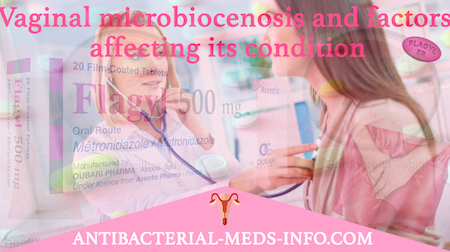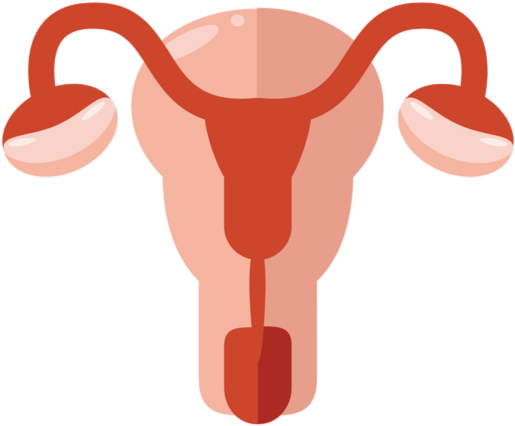Vaginal microbiocenosis and factors affecting its condition
The study of the vaginal biocenosis and the factors affecting its condition has been the focus of attention not only for clinical microbiologists for many years, but also for a wide range of clinical specialists. The search for new methods for the correction of dysbiotic states remains relevant, in light of which the use of eco-antibiotics should occupy its niche in clinical practice.
Normal human microflora is a combination of microbiocenosis, occupying numerous ecological niches on the skin and mucous membranes in places of contact of the human body with the environment. Microbiocenosis is a very sensitive indicator, reacting with quantitative and qualitative changes to any changes in the external and internal environment. A change in the number of a particular microorganism in a biotope or the appearance of bacteria not characteristic of a given habitat serves as a signal of adaptive or irreversible changes in the relevant link of the microecological system.
The study of the vaginal biocenosis is currently in the center of attention not only of clinical microbiologists, but also of a wide range of clinical specialists, since The functioning and harmonious interaction of all parts of the microecosystem is ensured by the activity of the immune, endocrine systems, reflects their functional state and depends on the factors of both the internal and external environment. Breakdown in one of these links invariably causes a violation of the microecology of the vagina, which can further lead to the development of inflammatory processes in the genital tract.
Today it is established that bacterial vaginosis is not only the cause of unpleasant discharge, but also a risk factor, and sometimes one of the causes of the occurrence of severe pathology of the female genital organs and complications of pregnancy and childbirth.
In 83% of patients suffering from disorders of the microbiocenosis of the urogenital tract, there are food, drug and mixed allergic reactions indicating a decrease in some adaptive mechanisms and tensions in the immune system
The biocenosis of the vagina is a microecosystem, the features of which are determined not only by the vaginal microflora, but also by the anatomical structure, the histological structure of the mucous membrane, and the biological properties of the vaginal fluid. parabasal, intermediate and surface. During cytolysis of surface cells, glycogen is released from the cytoplasm and becomes a nutrient substrate to ensure the energy and plastic processes of the normal microflora of the vagina.
The normal microflora of the vagina is divided into obligate, optional and transient. Obligate microorganisms are necessarily included in its composition, hinder the development
In 50–55% of women suffering from bacterial vaginosis, intestinal dysbiosis is detected, indicating a single dysbiotic process in the body with a dominant manifestation either in the genital or digestive system
pathogenic microbes in the vagina. Representatives of facultative microorganisms (non-pathogenic and opportunistic) are quite common, but not always found in healthy women. Transient microorganisms (non-pathogenic, conditionally pathogenic, pathogenic) are accidentally introduced into the genital tract from the environment. Under normal biotope conditions, they stay in the vagina for a short time and are quickly removed with a current of mucus and due to the activity of the mucociliary epithelium. In case of violation of protective mechanisms, pathogenic or conditionally pathogenic microorganisms of the transient or facultative flora are attached to the cells of the vaginal epithelium (adhesion) with subsequent reproduction and tissue damage, resulting in the development of an inflammatory reaction.
The main representatives of obligate microflora of the vagina of women of reproductive age are lactobacilli (Doderlein sticks). They play an important role in maintaining the normal biocenosis of the vagina due to the high competition and antagonism against most pathogenic and conditionally pathogenic bacteria. Lactobacilli metabolize glycogen to glucose and ultimately to lactic acid, which maintains the acidic moisture content (pH 3.8–4.4) required for the growth of the lactobacilli themselves.
The species composition of lactobacilli in women is different. Types of lactic acid bacteria (Lactobacillus) obtained from vaginal specimens of healthy women include: L. acidophilus, L. jensenii, L. casei, L. gasseri, L. crispatus, L. plantarum, L. fermentum, L. cellobiosus , L. brevis and L. salivarius. The most common are microaerophilic, hydrogen peroxide producing, less often anaerobic types of lactobacilli. Of particular importance in maintaining the normal microbiocenosis of the vagina belongs to lactobacilli that produce hydrogen peroxide, the detection rate of which ranges from 46.5 to 100%. Their number in the vagina is normally 105-109 CFU / ml. It is hydrogen peroxide produced by lactobacteria that, together with peroxidase from cervical mucus and halide compounds, inhibits the reproduction of many pathogenic microorganisms. So, according to the data, peroxide-producing lactobacilli are detected in 5% of women with bacterial vaginosis, in 37% with an intermediate type of biocenosis, and in 61% with a normocenosis. Thus, acidophilic microflora is a natural microecological barrier to the penetration of exogenous microorganisms into the vagina.
The protective properties of the endogenous microflora of the vagina are realized through the following mechanisms:
- ■ blocking adhesion receptors for extraneous microorganisms;
- ■ competition with exogenous infection for food substances;
- ■ stimulation of the motility of the epithelium of the mucous layer of the vagina and the process of its renewal on the cell surface;
- ■ production of short-chain fatty acids, peroxides and bactericides;
- ■ induction of an immune response against pathogens;
- ■ production of stimulants of immunogenesis and activators of phagocytic and enzymatic activity.
The accompanying microflora is represented mainly by aerobic, facultative anaerobic and strict anaerobic microorganisms. With a cultural study in the vagina of a healthy woman of reproductive age, more than 30 types of microorganisms can be identified. It should be noted that the use of modern molecular genetic methods of identification allows to identify more than 300 species of microorganisms in the vagina of a healthy woman. Studies of domestic and foreign authors have shown that in some women the normal microflora is maintained in the absence of lactic acid bacteria. Bacteria Atopobium, Megasphaera and Leptotrichia, which produce lactic acid as well as Lactobacillus, can be the dominant microorganism in the microflora. This is possible when the proportion of lactobacilli in the vaginal microflora decreases due to some reasons, in this case other lactate-producing bacteria occupy their niche in the microcenosis of the vagina.
Studies have shown that staphylococcus, mycoplasma, corynebacterium, streptococcus, peptostreptokokki, gardnerella, bacteroids, enterococci, enterobacteria, veylonellas and bifidobacteria, as well as yeast fungi of the genus Candida can also be part of the normal microflora of the vagina. The total specific weight of these microorganisms should not exceed 5–8%.
Many scientists have conducted several independent studies to characterize the vaginal microbial communities in women of reproductive age. At the same time, the authors found that the concept of a norm is relatively individual and depends on the ethnicity and geographical location of the place of residence.
Throughout the life of the female body, changes occur in the epithelium due to fluctuations in the secretion of ovarian hormones, the phases of the menstrual cycle, and pregnancy. Normally, the vagina of newborn girls in the first hours of life is sterile. During the first day, it is colonized by lactobacilli, as well as by other aerobic and facultative anaerobic microorganisms from the intestine. Under the influence of maternal estrogens, the vaginal epithelium cells accumulate glycogen, which splits into lactate, creating an acidic environment. During this period, the vaginal microflora in newborn girls is similar to the microflora of healthy adult women. After 3 weeks, maternal estrogens are fully metabolized, the epithelium becomes thin. The total contamination and the number of lactobacilli in the vagina is reduced, the acidic environment is replaced by a neutral one, strict anaerobes begin to dominate in the microflora, the microbial number decreases. In the pubertal period from the moment of activation of ovarian function and the appearance of endogenous estrogens, the thickness of the vaginal epithelium increases, the number of receptor sites for the adhesion of lactobacilli increases. Lactobacilli become the dominant microorganisms in the vagina.
The greatest thickness of the vaginal epithelium is observed at the maximum level of estrogen - in women of the reproductive period in the middle of the menstrual cycle. At the same time in the cytoplasm of cells contains a large amount of glycogen. With the entry of a woman in the postmenopausal period, the levels of estrogen and, accordingly, glycogen are significantly reduced in the genital tract. The overall level of bacteria, primarily lacto and bifidobacteria, is significantly reduced. The qualitative composition of the microflora becomes scarce with the predominance of obligate anaerobic bacteria. During this period, the pH of the vaginal environment becomes neutral. Some authors believe that the composition of the vaginal flora of healthy women of reproductive age is quite stable and practically does not change even during menstruation.
However, according to other researchers, the qualitative and quantitative composition of the vaginal microflora is subject to various changes. For example, during the menstrual cycle due to fluctuations in the secretion of sex hormones, days of lactobacilli dominance are replaced by days of predominance of gardnerellas and bacteroids.
To assess the state of the vaginal microflora A. F. Heurlein in 1910 proposed a bacteriological classification of four degrees of purity of the vagina, taking into account the number of leukocytes, epithelial cells, lactobacilli. Taking into account modern advances in clinical bacteriology and knowledge of the infectious pathology of the female genital organs, EF Kira developed a classification of the vaginal biocenosis, which presents the microscopic characteristics of 4 types of vaginal biocenosis corresponding to the main nosological forms:
1. Normality, characterized by the dominance of lactobacilli, the absence of gram-negative microflora, spores and mycelium of yeast-like fungi, the presence of single leukocytes and "clean" epithelial cells. This picture reflects the typical state of the normal vaginal biotope.
2. Intermediate type - moderate or reduced number of lactobacilli, the presence of gram-positive cocci, gram-negative rods. Leukocytes, monocytes, macrophages, epithelial cells are detected. It is a borderline type, often seen in healthy women, rarely accompanied by complaints and clinical manifestations.
3. Vaginal dysbiosis, expressed in a small amount or the complete absence of lactobacilli, abundant polymorphic gram-negative and gram-positive bacterial and coccal microflora, the presence of "key cells". The number of leukocytes is variable, there is a lack or incompleteness of phagocytosis. Corresponds to the microbiological picture of bacterial vaginosis.
4. Vaginitis (inflammatory smear type) - a polymicrobial smear pattern with a large number of leukocytes, macrophages, epithelial cells, marked phagocytosis.
In 1991, R.P.Nugent et al. proposed laboratory criteria for the diagnosis of bacterial vaginosis, which are still widely used in world medicine. They are based on a system of points (points), the combination of which assesses the degree of bacterial vaginosis by three bacterial vaginal morphotypes: A lactobacilli - large gram-positive rods (Lactobacillus acidophilus: large gram-positive rods); B - vaginal gardnerella and bacteroids - small gramvariable and gram-negative cocci (Gardnerella vaginalis and Bacteroides species: small gram-variable or gram-negative rods); C - mobilunkus - curved gramvariable sticks (Mobiluncus species: curved gram-variable rods). Vaginal vaginal smears are gram-stained and assessed on a 10-point scale based on the presence or absence of the morphological types of Lactobacillus in oily immersion (1,000-fold increase). The number of points from 0 to 3 indicates the prevalence of normal gram-positive microflora, 4–6 - intermediate state, 7–10 - condition corresponding to bacterial vaginosis, when small gram-negative rods, straight and curved rods with different Gram colors prevail in the sample.

The composition of the microflora of the vagina, both qualitative and quantitative, may be affected by the characteristics of the toilet of the genitals, the degree of sexual activity, as well as all kinds of contraceptive methods. A decrease in the concentration of lactobacilli occurs with the use of intrauterine contraceptives, antibiotics, antibacterial substances, after surgical interventions, with "hormonal stress" associated with abortion, in the presence of tumor processes, etc.
Special attention is given to the problem associated with the use of antibiotics, leading in some cases to a vicious circle. The need to use this type of drugs for the elimination of one infekta leads to aggravation of dysbiosis and the growth of other pathogens
The problem of vaginal dysbiosis during pregnancy is particularly acute, since it has a significant impact on the health and microflora of the newborn, as well as on the course of the postpartum period in puerperas. In a number of works it has been established that with the progression of pregnancy, the frequency of occurrence of conditionally pathogenic microorganisms increases. According to the authors, by the end of pregnancy, pathogenic and conditionally pathogenic flora amount to 51.4%, and the frequency of microbiocenosis disorders of the birth canal in women at risk of obstetric pathology during pregnancy averages 40–65%.
According to information available in the literature, we can conclude that the vaginal microflora significantly affects the course of the gestational process. According to B. Anderson, bacterial vaginosis was found in 84.6% of pregnant women with delayed fetal development in combination with sexually transmitted infections (STIs). There is evidence that intrauterine infection (IUI) is one of the important mechanisms that can explain the genesis of 25–40% of preterm labor. Preterm birth is the leading cause of neonatal mortality in the world, but the etiology of their occurrence remains largely unknown. A number of scientific studies indicate a potential relationship between the spectrum of identified bacteria in the amniotic fluid and the microbiota of the vagina, the latter being a permanent reservoir and a potential source of infection.
There is no doubt that the vaginal microflora affects both the course of pregnancy and the postpartum period, and the health of the newborn. During childbirth, the primary contamination of the child’s body with vaginal microflora occurs. The composition of the vaginal microflora of the woman determines the microflora of the conjunctiva, the gastrointestinal tract, the skin of the newborn, which become identical to the microflora of the mother's birth canal.
An in-depth study of violations of the vaginal microflora in obstetric practice has shown that the highest risk of developing infectious and inflammatory complications in women during childbirth and the postpartum period is observed in pregnant women with impaired vaginal microbiocenosis
Postpartum infectious and inflammatory diseases are an important medical and social problem. Their frequency, according to various authors, ranges from 5 to 26%, and in the structure of causes of maternal mortality in the United States, they occupy 2-4th place. At the same time, maternal mortality from septic complications accounts for 13–15%.
The state of the vaginal microflora is influenced not only by hormonal changes, violations of specific and nonspecific mechanisms of the immune defense of the macroorganism, but also general and local antimicrobial therapy.
Prevention of postpartum infection includes the identification of risk factors for inflammatory diseases, rehabilitation of genital and extragenital infections, including vaginitis, rational management of labor and should begin in the antenatal clinic and continue in the maternity hospital. The frequency of postpartum complications does not have a clear tendency to decrease, which is associated with an increase in the number of women with concomitant extragenital pathology induced by pregnancy, hormonal treatment and surgical correction of ICN during recurrent miscarriage, an increase in the frequency of operative delivery, wide (sometimes irrational) use of antibiotics, etc.
The occurrence of infectious and inflammatory diseases (IVZ) caused by auto-flora is the most well-known, although not the only consequence of an impaired immune and or microbiological equilibrium of the human body. Among the main reasons leading to the growth of opportunistic infections, most authors unanimously consider aggressive antibiotic therapy and the expansion of the immunodeficient population, including among pregnant women. At present, it is considered proven that the main cause of the development of diseases associated with the disturbance of the normal microbial landscape of mucous membranes is the lack of immunobiological homeostasis of the macroorganism. So, on the one hand, a violation of the normocenosis causes inhibition of local immune reactions, and on the other hand, against the background of a decrease in immunobiological protection, conditions arise for the realization of the pathogenic action of commensals, which, in turn, further aggravates the body’s immunological inconsistency.
Successful treatment of bacterial vaginosis, like any disease, depends on the correct and timely diagnosis and pathogenetically substantiated therapy. Based on the notion that vaginosis is not inflammatory, but still an infectious process, many practitioners use primarily antibacterial agents with different mechanisms of action.
The main directions of treatment of bacterial vaginosis are selective decontamination (selective elimination of pathogens) and restoration of normal vaginal microflora in order to relieve clinical symptoms, normalize laboratory parameters, prevent the development of possible complications during pregnancy, as well as during the postpartum period and during invasive gynecological procedures.
Currently, there are many methods for the correction of vaginal microflora. Despite numerous schemes and approaches, the search for an effective method of treatment continues to this day.

